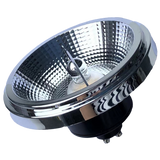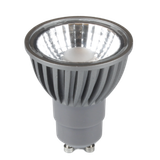THORGEON Reflector LED spots


































thorgeon reflector led spots optical performance and beam control
Accent work lives or dies by candela, not brochure lumens. With tight 10°–60° options, controlled spill, and SDCM ≤3, thorgeon reflector led spots hold punch on verticals without washing neighbouring planes. Typical packages run 350–1 200 lm at 4–12 W, CRI 90 for retail and galleries, PF ≥0.90, and flicker metrics within PstLM/SVM guidance on approved dimmers. On ceiling grids, plan centre-beam candela and mounting height first; a 24° cone at 3 m gives crisp 3:1 accents on merchandise when thorgeon reflector led spots are spaced to the beam edge rule.
thorgeon led reflector lamps formats and photometry
Aparatures include GU10 mains and GU5.3 MR16 12 V, with 24°/36°/60° beams, opal or clear fronts, and ripple-controlled drivers. Thermal paths use aluminium spines so L80 projects 25–50k h from LM-80/TM-21 families when Tc stays below mark. Installers tag thorgeon led reflector lamps by lumen bin, CCT 2700/3000/3500/4000 K, and beam to keep rooms identical after churn; in sealed cans, choose enclosed-rated thorgeon led reflector lamps and verify Tc at one hour.
thorgeon spotlight reflectors materials and thermal notes
Specular reflectors push peak candela; micro-prism faces soften spill where glare limits are tight. Bodies in reinforced PA with die-cast heat sinks keep mass within lampholder limits; GU10 collars handle repeated service without loosening. Respect insulation clearances above heads and avoid stuffing voids that choke convection—hot trims shift colour and shorten life. With thorgeon spotlight reflectors, aim 30–35° to control reflections on glass, then log bracket offset and torque so night crews can repeat thorgeon spotlight reflectors positions room-to-room.
thorgeon focused beam lighting applications and spacing
Museums, boutiques, and reception walls lean on precise beams to create 3:1–5:1 accent ratios over ambient. Corridor art uses 24° at 2.7–3.0 m; jewellery and small objects call for 10°–15° with higher candela. For mixed ceilings, corridor-friendly 36° avoids “hot doughnuts”. Designers pick thorgeon focused beam lighting when the same footprint must deliver both punch and soft edge variants; operations then repeat thorgeon focused beam lighting SKUs per floor so aiming charts and lux checks stay predictable.
thorgeon indoor reflector spotlights controls and dimming
Trailing-edge gives quiet, smooth low-end (5–10 % typical); DALI and 0–10 V versions keep scenes aligned across bays. Minimum level and curve type are published so scenes can be cloned between rooms. Emergency circuits use maintained drivers with declared emergency flux where required. Estates standardise thorgeon indoor reflector spotlights by control method and CCT to avoid colour drift between spaces; service teams keep thorgeon indoor reflector spotlights in labelled bins by beam for fast swaps.
thorgeon directional led reflectors integration with fittings
Front-glass options protect open luminaires; bezel kits hide rough cut-outs and keep planes flush. Terminals accept 0.5…2.5 mm², strip 8–10 mm; glands M16/M20 maintain enclosure IP. Shield terminations land 360° at the entry plate to stop VFD noise creeping into controls nearby. Using thorgeon directional led reflectors with documented ferrule sizes and torque notes keeps acceptance tests unambiguous; the same thorgeon directional led reflectors geometry fits legacy trims without pushing door clearances.
thorgeon high intensity spot lamps selection for B2B buyers
Lock target luminance and centre-beam candela first, then choose beam and CCT by substrate—metals tolerate tighter cones than matte fabrics. Confirm transformer or dimmer pairing on MR16/phase-cut lines; specify low-inrush drivers on relay banks. Publish Tc, torque, and spacing in the worksheet so crews don’t guess. Procurement lists thorgeon high intensity spot lamps by lumen class, beam, and control to stabilise stock; planners pilot one bay of thorgeon high intensity spot lamps to validate UGR and uniformity before bulk release.
Technical specifications and standards for engineers
- Optical: 10°/15°/24°/36°/60° beams; CRI 90 typical; CCT 2700–4000 K; SDCM ≤3.
- Electrical: 220–240 V GU10 or 12 V AC/DC GU5.3; PF ≥0.90; surge 1–2 kV L-L; inrush data for relay sizing.
- Thermal: observe Tc point; allow breathing space above heads; avoid insulation contact unless rated.
- Compliance: caps per IEC 60061; modules per EN 62031; luminaire interfaces per EN 60598; EMC per EN 55015 / EN 61547.
- Mehanics: weight within lampholder limits; front-glass SKUs for open fittings; collars and spacer rings for uneven plaster.
Applications and compatibility
Retail feature walls, galleries, hotel lobbies, and reception backdrops benefit from consistent beam families across floors. In offices, use 36° CRI 90 to lift task objects without screen glare; in corridors, favour 24° to reach artwork at height. Frames, glands, and terminal windows keep the same metric threads across your ecosystem, so tools and ferrules don’t change between spot kits and panels.
Selection checklist for project engineers
- Fix accent ratio and mounting height, then select beam and candela.
- Choose CCT/CRI by material palette; note scene targets.
- Confirm control topology—phase-cut vs DALI/0–10 V—and publish approved pairings.
- Check envelope against trim and “enclosed-rated” requirement; verify Tc after 60 min.
- Record torque, strip window, gland size, and label format for acceptance tests.
- Room-bundle by beam and lumen class; hold spares by the same codes to avoid mixed appearance.
Advantages of working with Bankoflamps
We schedule deliveries the way crews focus and aim—by room bundle, not catalogue page. Quotes with EAN/MPN land in about an hour, and live EU stock is shown before teams are booked. Your portal lists lead times, shipment tracking, and downloadable price files with validity windows that actually hold budgets. Trusted accounts can use post-payment up to 30 days. We consolidate per zone so lamps, trims, collars, glands, and dimmer gear arrive together, and your manager cross-checks beam sets, lumen bins, control topology, Tc limits, ferrule sizes, and torque notes against your drawings—keeping reflector kits site-ready across France, the Baltics, Germany, Spain, Italy, Belgium, and the Netherlands.